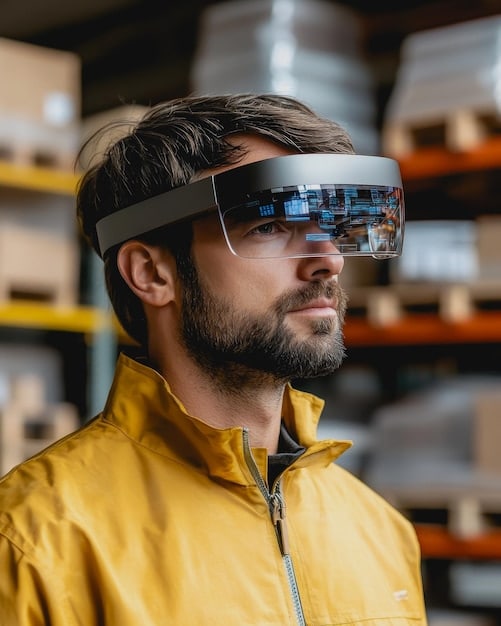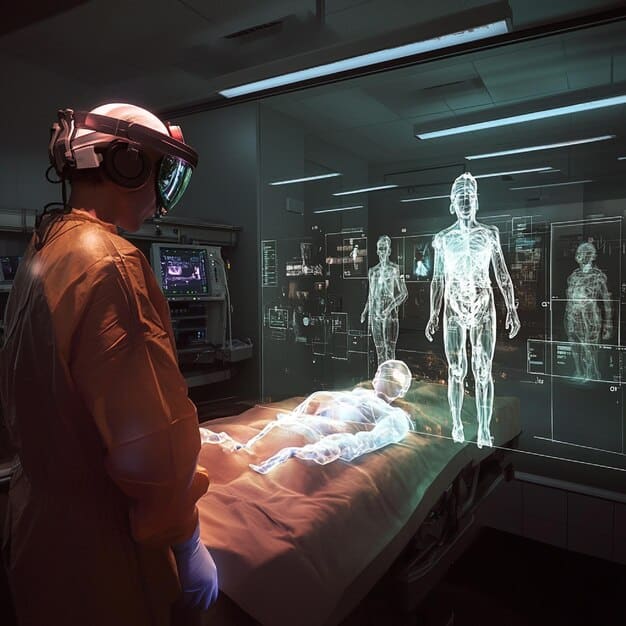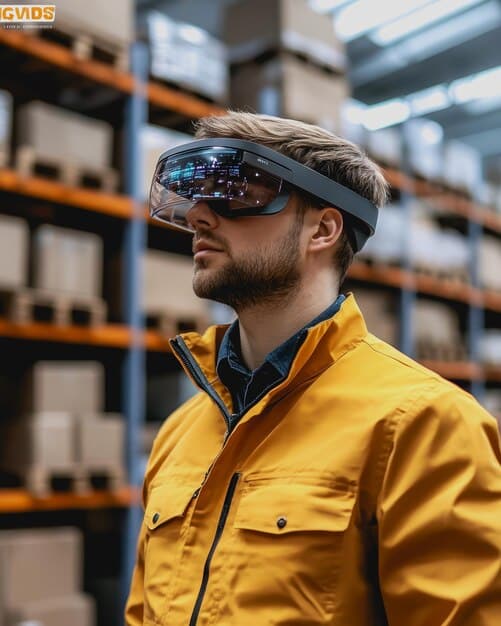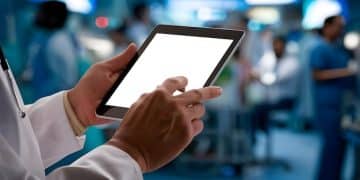Augmented Reality in US Industries: Promising Applications

What are the Most Promising Applications of Augmented Reality (AR) in US Industries? AR is revolutionizing various sectors by enhancing real-world experiences with digital overlays. From healthcare to retail, AR applications are boosting efficiency, engagement, and innovation across the US economy.
Augmented Reality (AR) is no longer a futuristic fantasy; it’s a present-day reality transforming industries across the United States. What are the Most Promising Applications of Augmented Reality (AR) in US Industries? As technology advances, AR is finding innovative uses that enhance productivity, customer experiences, and overall operational efficiency. Let’s explore the key sectors where AR is making a significant impact.
Exploring Augmented Reality Applications in US Industries
Augmented Reality (AR) is rapidly changing how businesses operate and how consumers interact with products and services. To fully understand, we must unpack the most promising applications transforming various sectors.
From healthcare to retail, the potential of AR is vast. Let’s delve into the specific ways that this technology is revolutionizing US industries.
Benefits of AR Implementation
Implementing augmented reality can offer numerous advantages. These benefits can range from increased efficiency to improved customer satisfaction.
- Enhancing training programs through interactive simulations.
- Improving operational efficiency by providing real-time data.
- Creating immersive and engaging customer experiences.
- Reducing errors in complex tasks with AR-guided assistance.
In summary, augmented reality is poised to revolutionize how businesses deliver value. It enhances both operations and customer experiences.

The Impact of Augmented Reality in Healthcare
The healthcare sector is witnessing a remarkable transformation through the integration of augmented reality. This technology offers innovative solutions that enhance patient care, training, and operational efficiency.
AR applications in healthcare are enhancing diagnostics, surgical procedures, and patient education. Let’s examine some key applications.
AR in Surgical Procedures
AR technology is revolutionizing surgical procedures by providing surgeons with real-time, three-dimensional visualizations. This leads to greater precision and reduced invasiveness.
Surgeons can use AR to overlay critical patient data onto their field of vision. This improves the accuracy of procedures and reduces the risk of complications.
AR for Patient Education
Patient education is another area where AR is making a significant impact. By using AR applications, healthcare providers can offer interactive and engaging learning experiences.
Patients can visualize their conditions and treatment plans in an understandable format. This leads to better adherence and overall satisfaction.
The integration of augmented reality into healthcare is improving patient outcomes and transforming the way medical professionals deliver care.
Transforming Retail with Augmented Reality
The retail industry is undergoing a significant transformation through augmented reality. AR helps to provide a personalized and engaging customer experience.
Through AR, customers can visualize products in their own space before making a purchase. Creating new opportunities for engagement and sales.
Virtual Try-On Experiences
One of the most exciting applications of AR in retail is the virtual try-on experience. Customers can use AR to virtually “try on” clothing, accessories, and makeup without physically going to a store.
Virtual try-ons improve customer satisfaction by allowing them to make informed purchasing decisions. This also reduces the likelihood of returns.
Interactive Product Demos
AR can also be used to create interactive product demos that provide customers with a deeper understanding of product features and benefits.
- Customers can see how furniture would look in their homes.
- They can also visualize how appliances would fit into their kitchens.
- AR provides a practical understanding of how products would integrate into their lives.
- AR enhances the shopping experience by combining digital and physical interactions.
Augmented reality is revolutionizing the retail industry by creating immersive and practical shopping experiences that drive sales and customer loyalty.

Augmented Reality in Manufacturing
The manufacturing sector is experiencing a considerable boost from augmented reality. AR provides solutions that enhance productivity, safety, and training.
From streamlining assembly processes to improving quality control, AR is an indispensable tool for modern manufacturers. Let’s explore some of its specific uses.
Enhancing Assembly Operations
AR technology enhances assembly operations by providing workers with step-by-step instructions and real-time guidance. This reduces errors and improves the overall efficiency of the assembly process.
AR can overlay digital instructions directly onto the physical workspace. This makes it easier for workers to follow complex procedures.
Improving Quality Control
Quality control is also improved through the use of AR. Inspectors can use AR devices to identify defects and inconsistencies faster and more accurately.
- AR-enabled inspections reduce the time needed to identify and address defects.
- They also improve the overall quality of manufactured products.
- Augmented reality ensures adherence to quality standards throughout the manufacturing process.
AR is transforming manufacturing operations, enhancing both efficiency and product quality.
Expanding Use of AR in Education
The education sector is also seeing transformative change because of augmented reality. AR applications are creating engaging and interactive learning experiences for students of all ages.
AR enriches the curriculum with more immersive environments. Making learning more exciting and effective by bringing the content to life.
Interactive Learning Modules
AR is used to develop interactive learning modules that enable students to explore subjects in a more engaging way. These modules can be applied to subjects ranging from science to history.
Students can interact with digital models and simulations, making learning more hands-on and memorable. It increases comprehension and retention.
Virtual Field Trips
Virtual field trips offer a chance for students to explore locations and cultures from the comfort of their classroom. AR can make these trips more realistic and exciting.
- Students can visit historical sites or explore different ecosystems.
- AR improves the educational experience by providing interactive and informative content.
- Virtual field trips accommodate diverse learning styles through visual and interactive components.
Augmented reality enhances education, by creating immersive and interactive learning opportunities that improve student engagement and understanding.
Logistics and Supply Chain Augmented Reality
Augmented reality is optimizing the logistics and supply chain in several United States industries. AR advances include enhancements in efficiency, safety, and accuracy through various processes.
AR applications in logistics are streamlining warehouse operations. They also enhance transportation management and improve overall supply chain visibility.
Optimizing Warehouse Operations
AR enhances the visibility into operations. It optimizes the navigation and package management through step-by-step instructions.
AR reduces the time to perform tasks. The speed improvement translates to faster delivery times and increased efficiency for logistics companies.
### Improving Transportation Management
AR provides real-time data. The data provides actionable insights leading to a reduction in safety incidents during operations.
The insights gained through AR applications promote responsible and sustainable logistics. Reducing resource consumption through optimized routes.
AR contributes to the sustainability of the logistics by optimizing routes.
“`html
| Key Point | Brief Description |
|---|---|
| ⚕️ AR in Healthcare | Enhances surgical precision and patient education. |
| 🛍️ AR in Retail | Offers virtual try-ons and interactive demos. |
| 🏭 AR in Manufacturing | Improves assembly and quality control processes. |
| 🚚 AR in Logistics | Augments warehouse operations and transportation management. |
“`
Frequently Asked Questions
AR applications in healthcare include surgical visualization, patient education through 3D models, and remote assistance tools for rural medical professionals. These uses enhance precision and understanding.
AR improves the retail experience by allowing customers to virtually try on clothes or visualize furniture in their homes. This decreases uncertainty, and increases customer satisfaction and purchase confidence.
In logistics, AR optimizes warehouse navigation and inventory management. Real-time data analysis reduces turnaround times during delivery by augmenting operational efficiency of logistics.
Yes, AR can facilitate remote training by providing interactive simulations and step-by-step instructions. This reduces costs and ensures consistent training quality across all operations.
AR enhances safety by providing real-time alerts and guidance during manufacturing. Providing insights into potential problems before these occur, which reduces the risk of human error.
“`
Conclusion
What are the Most Promising Applications of Augmented Reality (AR) in US Industries? AR is transforming diverse sectors by enhancing efficiency, streamlining processes, and improving user experiences. By integrating digital information with the physical world, AR is helping US industries achieve new levels of innovation.
As AR technology continues to evolve, we can anticipate even more widespread adoption and transformative applications across various sectors. This would unlock new opportunities for growth and innovation in US industries.
“`html





